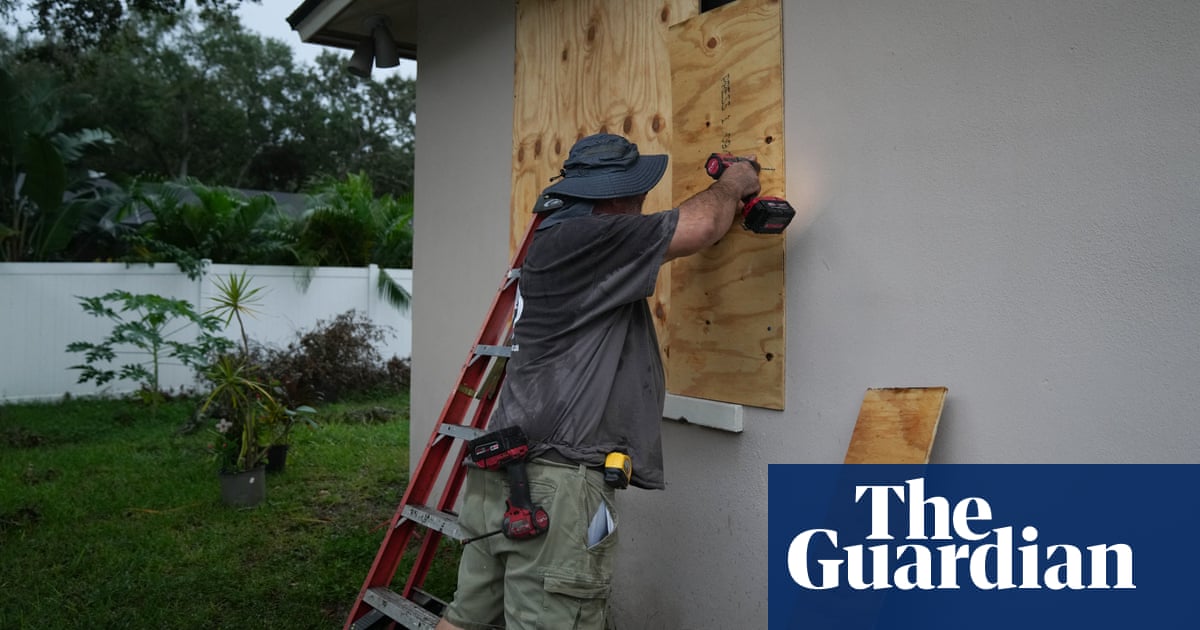Hurricane Milton has rapidly intensified into a category 5 hurricane, just two days before it is due to make landfall in Florida.
The National Hurricane Center (NHC) in Miami issued the updated forecast on Monday after saying the storm had become a category 4 hurricane more quickly than initially expected.
Meanwhile, the state is gearing up for what could be its biggest evacuation in seven years as the storm heads toward population centers including Tampa and Orlando just two weeks after Hurricane Helene caused more than 200 deaths and catastrophic damage from Florida into the Appalachian Mountains.
The storm cemented its major hurricane status on Monday as it moved over the Gulf of Mexico, with maximum sustained winds of 175mph (249km/h), the NHC said.
While fluctuations in intensity are expected, the National Weather Service said on Monday afternoon that Milton is forecast to remain an extremely dangerous hurricane through landfall in Florida.
Even if the storm somewhat weakens before landfall, projected for Wednesday or early Thursday, forecasters warned that levels of storm surge – Gulf waters pushed inland by the approaching hurricane – would be equivalent to the maximum category it reaches.
Milton could make landfall on Wednesday in the Tampa Bay area and remain a hurricane as it moves across central Florida into the Atlantic Ocean. On that track, it would be the 10th major hurricane – category 3 or higher – to make landfall along the US’s Gulf coast since 2017.
According to a CNN Meteorologist, Milton is now the third-fastest rapidly intensifying storm on record in the Atlantic. In less than 24 hours, Milton’s wind speeds increased by 90 mph, according to the National Hurricane Center and per forecasters, only two hurricanes have strengthened more than that in 24-hour period – Wilma in 2005 and Felix in 2007.
Experts attribute such a high rate of powerful, destructive storms to the climate crisis, which is spurred in part by the burning of fossil fuels.
In a post on X, Bill McKibben, the Schumann distinguished scholar of environmental studies at Middlebury College and the co-founder of 350.org, wrote that “22 hours ago Milton was a tropical storm” – but as of Monday “it’s a Cat 5 hurricane”.
“This,” he said, “is what happens on an overheated earth.”
Hurricane specialist John Morales gave an emotional report Monday on NBC, explaining that winds from Milton are 160mph and gaining strength in the Gulf of Mexico where waters are at record-high temperatures.
“You know what’s driving that … global warming and climate change leading to this and becoming an increasing threat for the Yucatan, including Merida and Progreso and other areas there,” Morales said, his voice breaking.
Weather officials said on Monday morning that Milton was expected to bring heavy rainfall, flooding, life-threatening storm surge and strong winds. They also said it will probably maintain its intensity for several days after reaching its peak.
The Florida governor, Ron DeSantis, said on Sunday that while it remained to be seen exactly where Milton would strike, it was clear the state was going to be hit hard.
“I don’t think there’s any scenario where we don’t have major impacts at this point,” he said.
“You have time to prepare – all day today, all day Monday, probably all day Tuesday to be sure your hurricane preparedness plan is in place,” DeSantis said. “If you’re on that west coast of Florida, barrier islands, just assume you’ll be asked to leave.”
With Milton achieving hurricane status, this is the first time the Atlantic has had three simultaneous hurricanes after September, according to the Colorado State University hurricane scientist Phil Klotzbach. There have been four simultaneous hurricanes in August and September.
The St Petersburg-Tampa Bay area is still cleaning up extensive damage from Helene and its powerful storm surge. In Pinellas county, which encompasses St Petersburg, at least 12 people died as a result from Helene.
At the end of September, Helene swamped parts of Florida’s westcoast, with the worst damage along the narrow, 20-mile (32km) string of barrier islands that stretch from St Petersburg to Clearwater.
This week, Pinellas county, as well as other counties nearby such as Hillsborough, Manatee and Sarasota, could see storm surge between 8 and 12ft above ground level, the National Weather Service said on Monday.
Rainfall amounts of five to 10 inches, with localized totals of up to 15 inches, are expected across portions of the Florida Peninsula and the Keys through Wednesday night, weather officials said, adding that there is risk of considerable flash, urban, and areal flooding, along with the potential for moderate to major river flooding.
DeSantis expanded his state of emergency declaration to 51 counties and said Floridians should prepare for more power outages and disruption, making sure they have a week’s worth of food and water and are ready to hit the road.
On Monday, Joe Biden approved Florida’s emergency declaration and ordered federal assistance to supplement state, tribal, and local response efforts due to the emergency conditions resulting from Hurricane Milton.
Florida officials said they were preparing for the largest evacuation the state had seen since Hurricane Irma hit in 2017.
They asked people who live in homes built after Florida strengthened codes in 2004, who do not depend on constant electricity and who are not in evacuation zones to avoid the roads.
Some areas in Florida, including Charlotte county, Pinellas county, and Hillsborough county have already issued mandatory evacuation orders for parts of the county with more areas expected to issue evacuation orders on Monday.
Orlando international airport announced it will cease commercial operations on Wednesday morning and will resume commercial operations as soon as it is safe again. Tampa international airport announced that they will be suspending flight operations from 9am Tuesday, and St-Pete Clearwater airport will also close.
On Florida’s east coast, officials have warned of heavy flooding, power outages, hurricane-strength gusts and rainfall totals of 6-8in.
In parts of Florida that are in Milton’s expected path, some schools and colleges have announced closures this week through Wednesday and Thursday in anticipation of Milton’s arrival.
As of Monday morning, hurricane watches, flood watches and storm surge watches were in effect for parts of the Gulf of Mexico and Florida’s west coast.
“Milton will be a historic storm for the west coast of Florida,” the National Weather Service said.
The Associated Press contributed reporting












